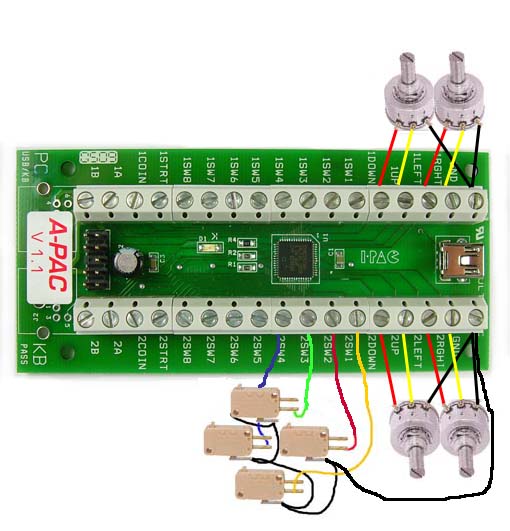What about this scenario...if it's booted with a pot connected, so it's in analogue, then the pot is disconnected, will it stay in analogue? Or will it go to digital immediately the pot is disconnected?
Brentglov observed that the A-Pac would only auto-detect pots and set the input to analog when the board booted up.
It wouldn't make sense to re-check and reconfigure the board during normal operation.
Andy would have designed it with the most efficient code loop possible ==> fastest possible sample/update rate and least lag.
Or... if one input on the APAC has a pot connected will the whole APAC be in analogue or only the input with the pot?
Only the input(s) where a pot is auto-detected should be set to analog.

I really hadn't anticipated this scenario. I had no idea the APAC would default to digital.
The build currently has a JPAC (just for digital... no video), an APAC and and OPTIPAC, which were planned to be left permanently connected.
There's an easy way to sidestep having the CP with pots connected during power-on -- add fake pots to the other CPs.
A normal pot has 5v (red), wiper (yellow), and ground (black) connections.

For your fake pots, just use two resistors of the same value. (R1 and R2)
- The rating of R1 and R2 is not critical since the A-Pac can use a wide range of pot resistance values so a pair of 2.2k, 3.3k, or 4.7kOhm resistors should work fine.
- Match the resistance of R1 and R2 as close as possible so the fake pot is "centered".
- Wattage rating isn't important since Ohm's Law shows a 5k pot will only draw 1mA of current from a 5v source (5v/5kOhms=1mA) and when you apply that current draw to the DC power formula you get 5v * 1mA = 5mW.
5v ---- R1 ----wiper ---- R2 ---- ground
The fake pot(s) will ensure the A-Pac initializes properly and keep the input(s) from floating. When you swap panels, the A-Pac shouldn't reboot/reconfigure.

Scott




 Home
Home Help
Help Search
Search Login
Login Register
Register
 Send this topic
Send this topic Print
Print



